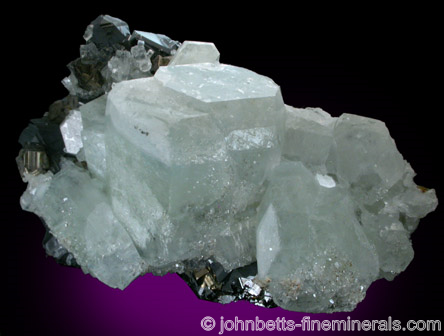The Mineral oligoclase

Oligoclase belongs to the Plagioclase Feldspar group, an isomorphous solid solution series. Albite is one member, containing sodium and no calcium. The other end member, Anorthite, contains calcium and no sodium. Oligoclase is an intermediary member of this series. Oligoclase is considered by some authorities as a variety of Albite rather than a separate mineral. The acclaimed Dana's System of
Mineralogy lists Oligoclase as an individual mineral,
whereas the IMA does not recognize it as individual mineral
species, but rather a calcium-rich variety of Albite.
Chemical Formula
(Na,Ca)Al1-2Si3-2O8
Color
Colorless, white, cream, yellow, orange, pink, light blue, light green, brown, gray. Often iridescent with schillers.
Properties
Streak
White |
Hardness
6 - 6.5 |
Transparency
Transparent to translucent |
Specific Gravity
2.63 - 2.67 |
Luster
Vitreous. Pearly on cleavage surfaces. |
Cleavage
2,1 - basal ; 2,1 - prismatic ; 3,1 - pinacoidal. The cleavage angle is about 90º. |
Fracture
Conchoidal to uneven |
Tenacity
Brittle |
Uses
Oligoclase is industrially important in the manufacture of ceramics. Crystals are popular among mineral collectors. Oligoclase is also known for its gem varieties: Sunstone and Moonstone.
Noteworthy Localities
Good Oligoclase crystals come from the Montijos Quarry, Monte Redondo, Leiria, Portugal. Masses of Moonstone Oligoclase come from Spruce Pine, Mitchell Co., North Carolina; and well-shaped white and colorless crystals were found in the Hawk Mine, Mitchell Co., North Carolina. Very good Moonstone Oligoclase was found in Middletown Township,
Delaware County, Pennsylvania.
An important Connecticut locality is Timms Hill, Haddam, Middlesex Co., Connecticut. Much of the Feldspar in rock on the island of Manhattan (New York City) is Oligoclase.
Excellent gem quality Oligoclase Sunstone comes from Norway at Bamble, Telemark; and at Tvedestrand, near Arendal.
Distingushing Similar Minerals
Potassium Feldspars - Don't exhibit striations on twinned crystal surfaces, whereas the Plagioclase feldspars do.
Other Plagioclase Feldspars - Usually cannot be determined by practical means.
Spodumene - Has a splintery cleavage.
Calcite - Much lower hardness.